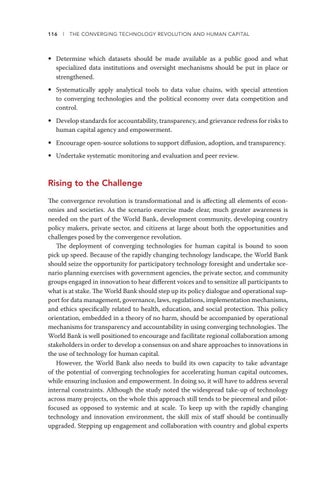116 l THE CONVERGING TECHNOLOGY REVOLUTION AND HUMAN CAPITAL
•• Determine which datasets should be made available as a public good and what specialized data institutions and oversight mechanisms should be put in place or strengthened. •• Systematically apply analytical tools to data value chains, with special attention to converging technologies and the political economy over data competition and control. •• Develop standards for accountability, transparency, and grievance redress for risks to human capital agency and empowerment. •• Encourage open-source solutions to support diffusion, adoption, and transparency. •• Undertake systematic monitoring and evaluation and peer review.
Rising to the Challenge The convergence revolution is transformational and is affecting all elements of economies and societies. As the scenario exercise made clear, much greater awareness is needed on the part of the World Bank, development community, developing country policy makers, private sector, and citizens at large about both the opportunities and challenges posed by the convergence revolution. The deployment of converging technologies for human capital is bound to soon pick up speed. Because of the rapidly changing technology landscape, the World Bank should seize the opportunity for participatory technology foresight and undertake scenario planning exercises with government agencies, the private sector, and community groups engaged in innovation to hear different voices and to sensitize all participants to what is at stake. The World Bank should step up its policy dialogue and operational support for data management, governance, laws, regulations, implementation mechanisms, and ethics specifically related to health, education, and social protection. This policy orientation, embedded in a theory of no harm, should be accompanied by operational mechanisms for transparency and accountability in using converging technologies. The World Bank is well positioned to encourage and facilitate regional collaboration among stakeholders in order to develop a consensus on and share approaches to innovations in the use of technology for human capital. However, the World Bank also needs to build its own capacity to take advantage of the potential of converging technologies for accelerating human capital outcomes, while ensuring inclusion and empowerment. In doing so, it will have to address several internal constraints. Although the study noted the widespread take-up of technology across many projects, on the whole this approach still tends to be piecemeal and pilotfocused as opposed to systemic and at scale. To keep up with the rapidly changing technology and innovation environment, the skill mix of staff should be continually upgraded. Stepping up engagement and collaboration with country and global experts
